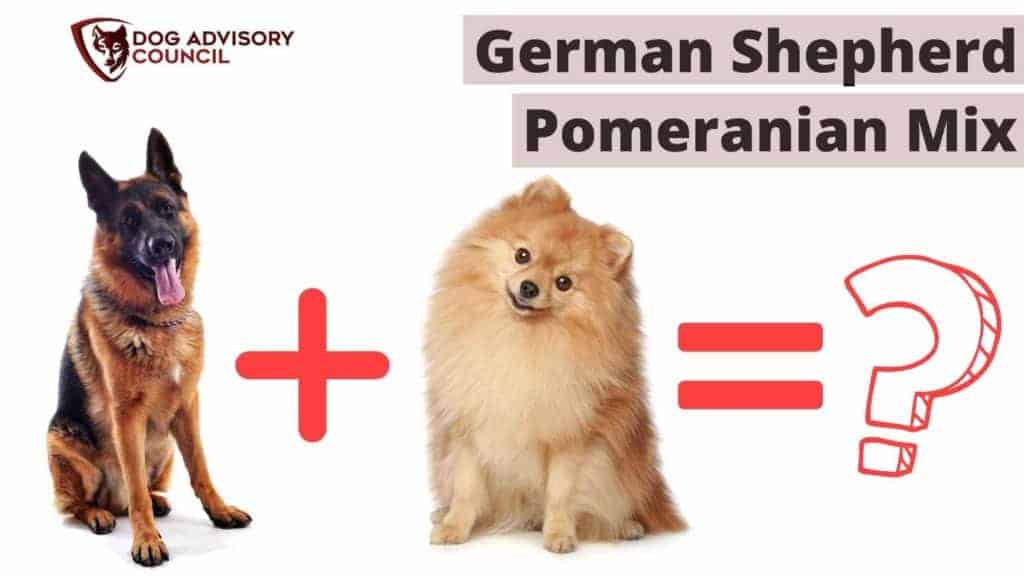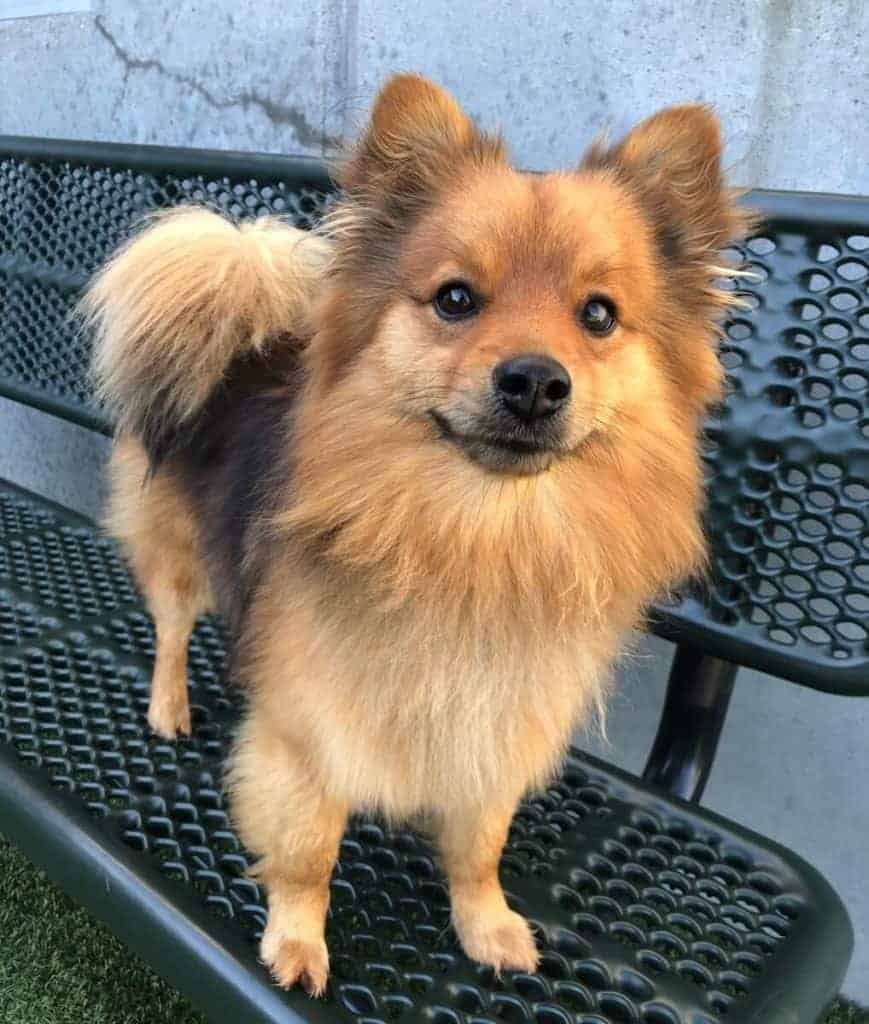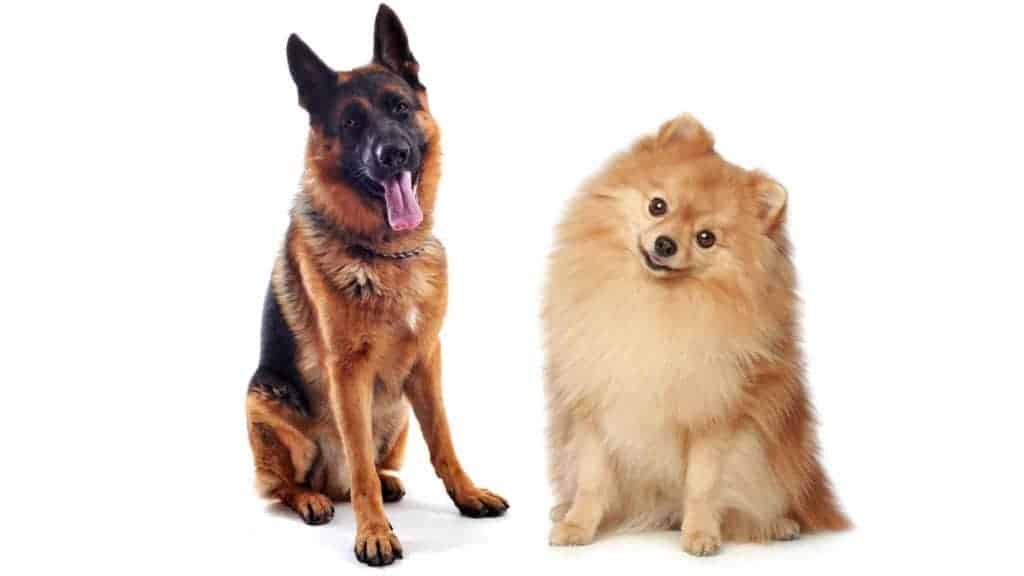
Some breeds make more sense than others. One of those that tend to cause some confusion when thinking about its roots is that of a German Shepherd Pomeranian mix. Curious?
Below, you’ll learn all about their temperament, lifespan, potential health conditions, and more.
A German Shepherd Pomeranian mix is a crossbreed involving one purebred parent of each. Because of the size difference in this breed, the height and weight can vary depending on which parent has the more dominant genes in your puppy.
Most tend to be about 12-16 inches (30-40 cm) and weigh between 25-30 pounds (11-13 kg). They have long hair and cured tails. Colors can range from German Shepherd markings to Pomeranian combinations.
What is a German Shepherd Pomeranian mix called?
This mix has earned the nickname German Pomeranian. These dogs are more popular in Europe than in the US as far as availability is concerned. However, despite this limited availability, they are the talk of many designer breed lovers online!
What does a German Shepherd Pomeranian mix look like?
As briefly mentioned, it really depends on which dog’s genetics come out stronger in your dog. These two look similar in some cases but not in others. Colors can include:
- Black
- Tan
- Brown
- Red/Orange
- Cream/White
- Fawn
- Sable
- Pure white
- White and black
- Blue
- Brindle
One of the coolest details about this mixed breed is that some look like a Pomeranian with GSD markings on their face, and others are really fun blends of fur colors and combinations. No two in one litter of pups are ever going to be identical. This is thought to be part of the charm for those who shop exclusively for designer dogs.
As also mentioned above, most will have a curled tail and long hair/fur. Some will have the mane effect that comes from their Pom parent. Most have erect ears that have tufts.
How big will a German Shepherd Pomeranian mix get?
It does vary, but most are considered medium-sized. They are often fluffy, though, so may look bigger when you have a “fluff factor”.
While they are tiny puppies, they will grow between 12-16 inches (30-40 cm) as adults and weigh between 25-30 pounds (11-13 kg). However, it’s very common to have size fall outside of these norms with a crossbreed like this.
If your primary consideration is the size of your to-be pup in your home (space is one of the main reasons that people look for this crossbreed), then you’ll want to talk to your breeder about it.
The size of the parents will help you determine the size that your pup will be. However, even with the best predictions, size can land anywhere between a Pom and a German Shepherd!
Can a German shepherd mate with a Pomeranian?
A very valid question! The simple answer: Yes, but with help. Traditional insemination is impossible, so female German Shepherds are artificially inseminated from male Poms. Since Pomeranians are too small to hold a liter of crossbred puppies, this is the only dynamic that works without jeopardizing the health of mom and pups.
What is the lifespan of a German Shepherd Pomeranian mix?
Bred from parents that both have good lifespans, you’ll be looking at anywhere between 10-15 years for your German Pomeranian.
Most of those years will be happy and healthy, but they can be prone to health conditions as they age. Most of these come from their Pom parent, but a GSD has some health concerns in there, too.

What are some health issues of a German Shepherd Pomeranian mix?
Some are more common than others, and many of these can be minimized by ethical and proper breeding practices.
However, some of the following can be common in even the beat and healthiest dogs:
- Hip and elbow dysplasia
- Luxating patellas
- Epilepsy
- Disc disease
- Cancer
- Degenerative myelopathy
- Dental diseases
- Skin issues/ Allergies
Hip and elbow dysplasia
This is a common aging concern for large dogs, so your puppy will get the likelihood from their German Shepherd parent.
The joint for the bone of their elbow or hip will not fit properly together, and this can cause friction, destruction of the joint, and more.
This becomes more and more pronounced with excessive use and will often need pain medication, physiotherapy, and other professional services.
Luxating Patellas
From their Pom parent, this is another common health concern. It involves the patella (their kneecap) moving out of place without warning.
It can be occasional or regular. As they age, it can be more frequent. This will lead to abnormal walking and even reluctance to exercise if it happens a lot.
Epilepsy
Caused by unknown causes, this is when the body starts to shake uncontrollably. It is often hard to treat and will require professional consultation from experienced veterinarians who can make treatment recommendations.
Disc disease
This is a condition where the discs start to degrade and cause pain in the nerves and spine in general. This condition is primarily due to the Pomeranian parent, but it can happen in larger dogs.
Surgery is often a treatment recommendation, but it would depend on how severe it is and where the discs are in the back.
Cancer
Just as with humans, cancer is prominent in dogs. It can be any kind of cancer and any kind of security. Proper vet check-ups and good health are vital criteria for helping keep your dog as healthy as possible and catching any potential cancer early in life.
Degenerative myelopathy
This comes mostly from their German Shepherd genes. When the nervous system starts to degrade, it leads to progressive weakness and eventually paralysis, mostly of their hind end. They will need some sort of wheelchair or harness to help them walk and move comfortably.
Dental Disease
Since dogs don’t often have the best dental hygiene, they often will have dental disease, which can be mild or severe.
It can lead to difficulty eating and powerful jaw and tooth pain. Proper dental hygiene is, of course, a great way to help prevent this.
Skin issues/allergies
These dogs need proper grooming (more on that a bit later), or they are prone to skin issues, including sores, dry skin, and more. GSDs are also more prone to allergies to byproducts in food, so you’ll need to be careful where you turn for their food type.
What is the temperament of a German Pomeranian?
One of the reasons that these dogs are so popular is because of their excellent temperament.
These sweet dogs tend to be alert, loyal, friendly, and active members of the family. They have a lot of energy but tend to get along with everyone. They often will get along well with kids, other pets, and more.
They can sometimes be territorial if their German Shepherd traits allow it, so if you have another alpha dog, it may take a while for everyone to figure out their turf.
These dogs may not always adapt well to newcomers or strangers, however. While polite and attentive to your guests, they might not like to be handled by them specifically. This is also the case with new pets or visiting pets. They’ll keep their distance and be watchful of these new additions now interacting with your dog’s family.
Are German Pomeranians good family dogs?
In most cases, yes! German Pomeranians are excellent family dogs because they tend to be perfect playmates for your child. They aren’t so big as to cause harm when playing, and they love the idea of having play buddies much as your children do. They get along well with kids and teens and will enjoy being in the thick of things.
That said, they will be best for families described as “active.” Since these are high-energy and exercise-high dogs, they won’t enjoy spending Saturday on the couch. If you are a family that likes to walk, hike, or go camping, your German Pomeranian will be a great companion for the adventure.
If you have a dog with especially strong German Shepherd traits, you may notice that they act similarly to a watchdog. That is, they’ll announce visitors, mail carriers, trespassers, and more.
Very few will bite or attack without warnings in growing and puffing themselves out “to their full size”. Because they are naturally territorial, you’ll want to be aware that aggression can sometimes go hand in hand with it.
What is the German Shepherd Pomeranian mix price?
Because these are popular breeds and rare, you can expect to pay anywhere up to $3 000 for a puppy. Seriously. They are hard to find from reputable breeders outside of Europe, which drives the price point up.
This crossbreed takes a lot of effort to design, especially with artificial insemination. All of this comes at a literal price!
Sometimes you can find them at $500 from a rescue organization, but this comes with the trade-off of being unaware of their history.
Pros and cons of a German Pomeranian
Of course, part of doing your research on your new furry addition is going to be in weighing the pros and cons of this adorable and fluffy breed. Here they are for you to take a look at:
PROS
- Agreeable and easy going
- Great for apartments or small homes
- Blend well with active families
All things considered, German Pomeranians are easy-going dogs. They enjoy being around their humans and are great additions to active families who want a dog to participate in camping trips and hikes.
Their small size makes them a more “convenient” option compared to classic larger dogs, too. They adapt well to apartments and small homes. While they will need exercise, it will be much easier to exercise them properly, even with smaller spaces available instead of large dogs.
They are lovely additions to families that want a loving and attentive family dog that will be a great companion to kids, other pets, and parents, too.
They’re also easy to train regarding obedience and basic commands (with one exception below). This is great for those that don’t want to be fighting their dog every 10 minutes.
CONS
- Can be difficult to house train
- Need 60 minutes per day or more
- Lots of health conditions
Thanks to their Pomeranian heritage, these dogs can be challenging to house train. Even with a proper dedication to training and their natural intelligence, these dogs don’t always house train well. You may want to consider looking at crate training where you can place pee pads, just so that they contain their messes in one area, at least.
These are active dogs that, despite their size, will require 60 minutes of activity a day. Many will need 90 to 120 minutes even. This can be split between walks/hikes with playtime and obedience training.
By blending movement with mental and emotional stimulation, you’ll help care for all of their needs also help curb any boredom that may come later.
Many families will choose to exercise their Pom before and after work specifically because they can destroy things out of sheer boredom if left alone all day. Another option is to get them distraction toys or consider doggy daycare.
Lastly, the list above will be something to consider when it comes to possible health conditions. These will require vet visits and specialist appointments if necessary when you are looking for a way to help them feel at their best as they get older.

How to take care of a German Shepherd Pomeranian mix
From daily maintenance to long-term care for their health, there are several areas that you can focus on for their benefit.
These areas are primarily around their beauty routine, weirdly enough, since both breeds will have some essential cosmetic needs to consider.
Get used to a groomer
Since they are long-haired, they will need to have regular trips to the groomers. Most will aim for 4-6 weeks. Going longer means that you will need to prioritize their grooming at home with a brush.
Skipping these grooming habits means that you will end up with tangled fur that can be loaded with bacteria, cause skin irritations, mats, and more. A German Pomeranian is not a dog to take home if you don’t “believe” in groomer care.
Even with a groomer, you will need to help them stay comfortable with brushing their fur at home every few days. This will help prevent any mats and can help them relieve themselves of loose fur as they shed their coats during shedding season.
Don’t forget their nails
Most will want to look at clipping their own dog’s nails. This is fine, but you can also look at blending it with their grooming specialist care too. These are the professionals who will know how to properly cut them down to help with wear and tear to your home and their health.
Even so, you’ll want to get used to at least clipping their nails every few days so that you can keep them in good health for a while between appointments. Think of it as a trim at home between appointments.
Next: ears and teeth
You’ll need to get comfortable with wiping out their ears to prevent infection (common with GSDs). This is often done with cotton balls and a bit of warm water if you need it. In case of infection, you will have antibiotics to use, so the sooner you get your dog used to the attention, the better.
Brush their teeth, too, so that they can avoid issues like dental decay and other common complications that can lead to a lot of health conditions as they age. You can do this through actual teeth brushing and even toys that are all about shaking plaque loose.
Face washed every other day
Another thing to get used to doing at home is caring for their face! Due to their Pom parent, they are prone to eye issues. You’ll need to get used to wiping their eyes clean and clear, and you’ll also need to make sure that you get their fur, too, so that they don’t have bacteria build up around their face.
On the whole
A mix between a German Shepherd and a Pomeranian, these tend to be fluffy and medium-sized dogs. While they can vary in size greatly due to genetics from each parent, most end up to be 12-16 inches (30-40 cm) high and weigh between 25-30 pounds (11-13 kg).
Some will have German Shepherd markings, and others will have Pomeranian colors and combinations. They have long hair and cured tails. They can be prone to many health conditions, so proper care is needed for their best quality of life.
German Pomeranians are beautiful and attentive family dogs for those that like to be on the move. While caring for them will be a little different than many may be used to, it will be a lifetime full of fun for those families who love a medium-sized dog.
If you know someone who will love one of these, consider sharing this with them to spread the love further!
